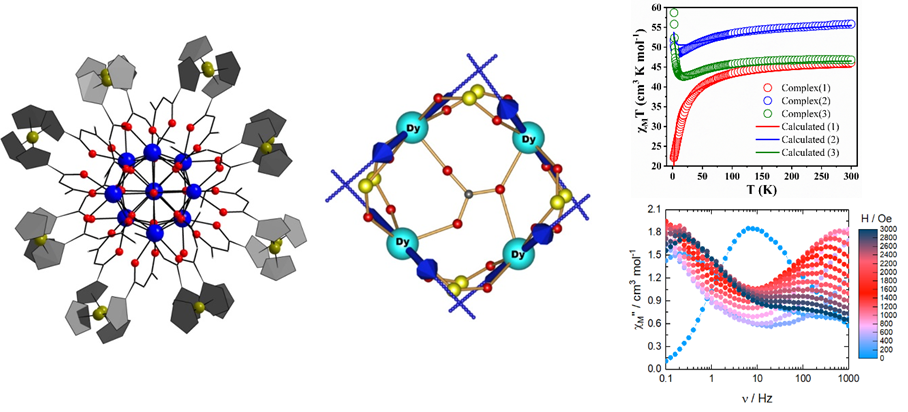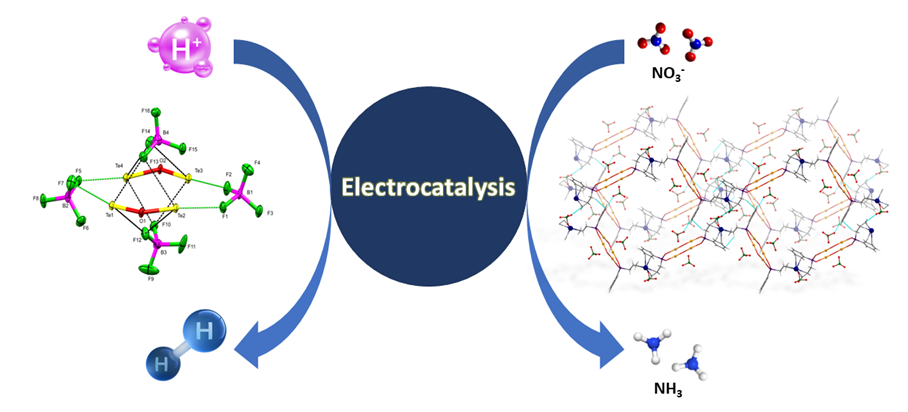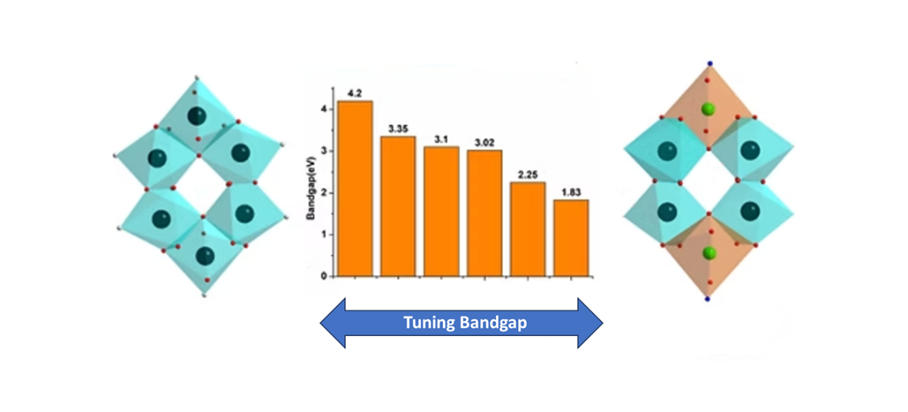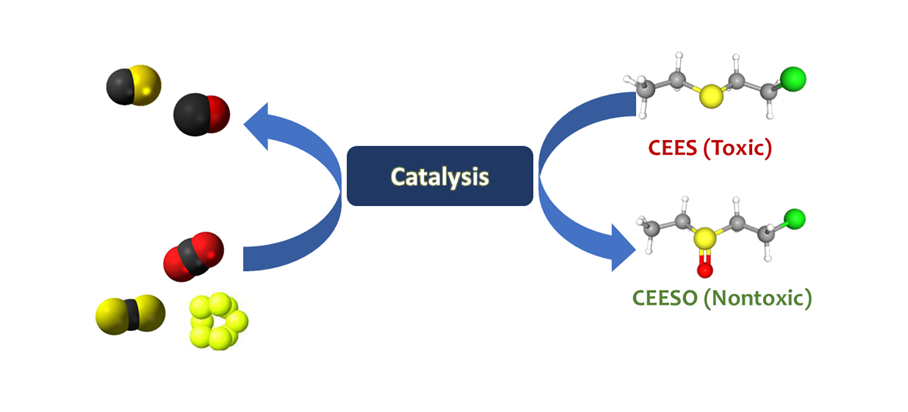Research
Home / Research
Novel Magnetic materials:
Magnetic materials are indispensable in the modern technological world. Many commonly used appliances, from medical instruments to data storage devices, use magnets. Single Molecule Magnets (SMM) are those molecules that show magnetic hysteresis below blocking temperature, and their magnetic behavior is purely molecular in origin, which can lead to breakthroughs in data storage applications. Polynuclear compounds that are bistable with toroidal magnetic state are defined as Single-Molecule Toroics (SMT), while Magnetocaloric Effect (MCE) is the phenomenon of temperature change brought about by the introduction or removal of magnetic field. Our lab is interested in synthesizing novel 4f-based molecular clusters that show SMM, SMT, and MCE phenomena.

References:
- 1. Mondal, S.; Chauhan, D.; Guizouarn, T.; Pointillart, F.; Rajaraman, G.; Steiner, A.; Baskar, V. Self-Assembled Lanthanide Phosphinate Square Grids (Ln = Er, Dy, and Tb): Dy4 Shows SMM/SMT and Tb4 SMT Behavior. Inorg. Chem. 2024, 63, 22338-22348.
- 2. Rasamsetty, A.; Das, C.; Sañudo, E. C.; Shanmugam, M.; Baskar, V. Effect of coordination geometry on the magnetic properties of a series of Ln2 and Ln4 hydroxo clusters. Dalton Trans. 2018, 47, 1726-1738.
Electrocatalytic Reactions:
Electrocatalysis has been of topical interest in the past few decades. Global warming and climate change due to the release of carbon dioxide and other greenhouse gases from using fossil fuels have demanded clean and renewable energy. In this regard, hydrogen gas has been promising as an alternate energy source. Also, electrocatalysis provides an avenue to convert harmful pollutants like nitrate, CO2, etc., to valuable products. Though many transition metal-based catalysts have been developed in this regard, the main group elements have been least explored. We have been actively involved in designing heavy main-group-based catalysts that can show reduction of nitrate to ammonia and Hydrogen Evolution Reaction (HER).

References:
- 1. Samuel, C.; Narsimhulu, G.; Bangar, G.; Dasari, S. H. K.; Rajaraman, G.; Baskar, V. Silver-π Interaction: A Diverse Approach to Hybrid Material and Its Efficacy in Electrocatalytic Reduction of Nitrate to Ammonia. Inorg. Chem. 2024, 63, 21670-21678.
- 2. Narsimhulu, G.; Samuel, C.; Palani, S.; Dasari, S. H. K.; Krishnamoorthy, K.; Baskar, V. Electrocatalytic hydrogen evolution mediated by an organotelluroxane macrocycle stabilized through secondary interactions. Dalton Trans. 2023, 52, 17242-17248.
Tailoring Optical Bandgaps:
Over the past decade, tremendous progress has been achieved in developing semiconductor materials. The bandgap is arguably the most important parameter for a semiconductor, as applications in solar cells, detectors, displays, sensors, etc., all depend on it. Materials whose bandgaps can be tailored for specific applications are highly desired. Our research group has been tuning the optical bandgap of stibonate/telluroxane-based systems by incorporation of 3d ions or by anion exchange. The potential of these systems is tremendous, and more advances are being made.

References:
- 1. Navaneetha, T.; Ugandhar, U.; Samuel, C.; Guizouarn, T.; Pointillart, F.; Raghunathan, R.; Baskar, V. Tunable bandgap in self-assembled transition metal-incorporated heterometallic M2Sb4 (M = V, Mn, Co, Ni, and Cu) oxo clusters. Dalton Trans. 2023, 52, 9328-9336.
- 2. Ugandhar, U.; Navaneetha, T.; Ali, J.; Mondal, S.; Vaitheeswaran, G.; Baskar, V.; Assembling Homometallic Sb6 and Heterometallic Ti4Sb2 Oxo Clusters. Inorg. Chem. 2020, 59, 6689−6696.
Catalysis and Small Molecule Activation:
Catalysts have defined the modern era. From organic synthesis to pharmaceutical applications, catalysts have become an indisputable part of chemistry. Developing novel catalysts is of utmost importance as it reduces costs and improves production efficiency. We have been developing 3d/4f-based catalysts for small molecule activation and various other reactions.

References:
- 1. Samuel, C.; Navaneetha, T.; Ali, J.; Baskar, V. Cerium(III) Phosphinate and Cerium(IV) Phosphostibonate Acting as Catalyst for Mild, Selective Sulfoxidation. Inorg. Chem. 2025, Article ASAP.
Biological Studies:
With the advent of the modern world, various diseases have arisen due to various factors. As drug-resistant bacteria and the non-availability of a perfect cure for cancer exist, there is an ever-increasing need to develop novel drugs. Our contributions to this have been the development of antimony-based systems that show antibacterial and anticancer activities. Though not perfect, the hunt is on, and main-group-based systems might hold the key to the next breakthrough.

References:
- 1. Navaneetha, T.; Ali, A.; Ramana, C. V.; Baskar, V. Discrete Molecular Aggregates Based on Zn(II) and Sb(III)/(V) Ions Displaying Efficient Antibacterial and Antioxidant Properties. Inorg. Chem. 2023, 62, 5237–5247.
- 2. Ali, J.; Mubarak, M. M.; Samuel, C.; Kantroo, H. A.; Malik, A.; Ahmad, Z.; Baskar, V. Stibonic acids and related stibonate-phosphonate clusters: Synthesis, characterization and bioactivity evaluation. J. Inorg. Biochem. 2022, 111, 111909.
